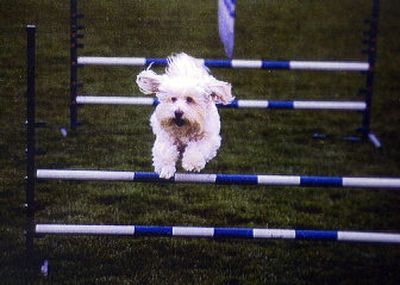Dogs and owners romp, learn through group

They warm up to music. Running around in circles, smiling at one another and wagging their tails. They are members of the Spokane Dog Training Club, and they have brought their owners. Bailey, a 4-year-old bearded collie is at the end of Diane Birkner’s leash. His hair is kept out of his eyes by a rubber band on top of his head.
Bailey has been attending classes for about three years. Birkner’s other dog, Katie, a 6-year-old cockapoo, has stayed at home. She has been in school for five years and is taking a vacation. She started in puppy kindergarten. “My vet told me that if I hadn’t put Katie in kindergarten, she would have been a juvenile delinquent,” said Birkner.
SDTC is a not-for-profit membership club. Affiliated with the American Kennel Club, the group has about 70 members who, besides attending classes, all pitch in by operating programs and teaching courses. The classes are open to the public.
“It is a unique organization,” said Mary Jane McCall, director of training for SDTC. “It is completely run by volunteers who share a common love of dogs.”
The goal of SDTC is to teach responsible dog ownership through education and training. Members and their dogs are active in the community, volunteering many hours in hospitals and nursing homes, and holding educational demonstrations.
Katie’s breeder had insisted that Birkner pick her up nearly two weeks earlier than optimal for a puppy to be taken from its mother. The classes helped immensely and Katie has adjusted well.
Both dogs have earned their canine good citizen certificate from the AKC, and both will be starting agility training in April.
Bailey is currently in rally, one of many classes offered by SDTC. In rally, the dog and handler complete a course of designated stations. Each of these stations has a sign providing instructions regarding the next skill that is to be performed. Start, halt, fast forward from sit and walk around dog are all performed continuously at a brisk pace with the dog under control within a two-foot area at the handler’s left side.
Initially, the dogs must go through obedience training (puppy kindergarten or beginning home companion) so they will be prepared in the “classroom.” SDTC’s classes are appropriate for both companionship and competitive obedience and include agility, flyball, tracking, herding and conformation.
While observing a class, at first it’s not easy to notice the subtle hand motions, but once you do, a pattern emerges. In work mode, the dog is constantly waiting for commands. A slight hand raise might mean “up” while a nose tap might relay “sit.” It is slightly different for every dog, and when the handler’s stance relaxes or the handler says “OK,” the dog recognizes it as “at ease,” and is released from work mode. Most handlers have treats tucked into a pocket or fanny pack.
One thing dogs need to learn, McCall said, is that their human is the pack leader. They need to know their boundaries and who the boss is. They need to earn their “cookies.”
Cesar Millan, the dog whisperer, agrees, “The sooner you set rules, boundaries and limitations, the sooner you get to enjoy a healthy, happy and balanced dog.”
Birkner has reaped the benefits of raising healthy, happy and balanced dogs. Birkner believes that her dogs keep her multiple sclerosis at bay. “They inspire and comfort me,” she said.